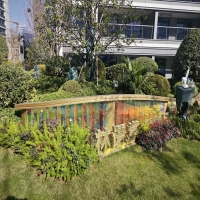Welcome to the website for landscape facilities products and knowledge.
How does the Landscape Round Table accommodate users with mobility or physical limitations?
The great outdoors should be a place of connection and enjoyment for everyone, regardless of physical ability. A common question that arises is: how does the Landscape Round Table accommodate users with mobility or physical limitations? The answer lies in a foundation of thoughtful, inclusive design that goes beyond mere compliance to create a genuinely welcoming space.
Traditional picnic tables often present significant barriers. Their fixed benches and high central pedestals can make them impossible to approach for someone using a wheelchair or walker. The Landscape Round Table reimagines this classic design from the ground up. Its most critical feature is the extended tabletop that cantilevers over a uniquely designed, C-shaped base. This innovative structure creates generous open spaces at the table's perimeter, allowing a wheelchair user to roll directly up to the table without encountering obstructive legs or footings. The table surface is positioned at a standard height that comfortably accommodates a seated individual.
Furthermore, the design intentionally provides clear knee space under the table, ensuring that users can sit close and engage comfortably with others. While some models offer extended tabletop lengths to create even more room, the core design inherently supports side-by-side seating, fostering social integration rather than segregation. This approach means that a family or group of friends, including a member who uses a wheelchair, can all sit together at the same table, sharing a meal and conversation as one unified party.
The benefits of this accessible design are universal. It is not solely for individuals with permanent disabilities; it also assists parents with strollers, elderly individuals with reduced mobility, or anyone recovering from a temporary injury. By eliminating physical barriers, the Landscape Round Table promotes dignity, independence, and social inclusion. It transforms a simple piece of outdoor furniture into a powerful tool for building community, ensuring that public and private spaces are truly open and enjoyable for all. It stands as a testament to the principle that when we design for accessibility, we ultimately design a better experience for everyone.
Related search:

Recommendation
Metal and acrylic color-changing combined curtain wall for large-scale public landscape facilities